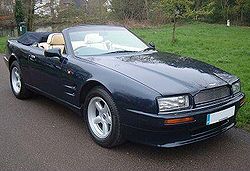Aston Martin Virage

The Virage was Aston Martin's replacement for the decades-old V8 models. Introduced at the Birmingham Motor Show in 1988, it was joined by the high-performance Vantage in 1993, and the name of the standard car was changed to V8 in 1996.
This V8-powered car was intended as the company's top model, with the 6-cylinder 1994 DB7 slotted below it. Although the DB7 switched to a V12 engine and claimed the performance crown, this V8 model (by then in Vantage form) remained the exclusive, expensive, and hand-built king of Astons. It was replaced in 2000 with the Vanquish. The V8 Vantage name reappeared on a new entry-level model in 2005. By the end of the 2000 model year, 1,050 of all Virage related models had been produced.
The design was fresh and modern, looking more like a Lagonda than the V8 it replaced. Indeed, the chassis was an evolution of the Lagonda's, though without its de Dion tube rear suspension, instead a cumbersome aluminium A-frame design cited as one of the Virage's handling downfalls, and the same double wishbones in front. To cut costs, many of the less-important pieces came from other companies, as had been the case for many an Aston past. The sleek headlights and taillights were Audi 200 and Volkswagen Scirocco units, respectively, while General Motors, Jaguar, and Ford provided the steering column, climate control panel, and dash switches. In fact, Ford purchased Aston Martin and Jaguar shortly after the Virage debuted.
The Virage was a large, heavy car, but the 32-valve 5.3 L (5340 cc) V8 engine's 350 ft·lbf (475 N·m) torque elevated its performance to near sports car levels. "Acceleration just never seems to run out", claimed Sports Car International on a first test. They also praised the "eager and quicker revving" nature of the 330 hp (246 kW) engine with its Callaway-designed heads and Weber-Marelli fuel injection. "Nothing sounds quite like an Aston V8," they concluded. The 1790 kg (3946 lb) car could reach 158 mph (254 km/h).
The Virage Volante convertible debuted for 1992 as a 2-seat car, but all production examples featured 2+2 seating. Sources claim 224 to 233 examples produced when the series ended in 1996. A new V8 Volante, with styling based on the V8 Coupe and supercharged Vantage was built from 1997 to 2000 on a lengthened chassis. 63 long chassis V8 Volante's were built.
In January, 1992, Aston Martin introduced a conversion service, transforming the car into a Virage 6.3. As the name implies, the centerpiece of the conversion was a 6.3 L (6347 cc) V8 derived from the AMR1 racing car. This engine produced 500 hp (373 kW) at 6000 rpm and 480 ft·lbf (651 N·m) at 5800 rpm, allowing the car to reach 175 mph (282 km/h).
Other changes included 362 mm (14 in) ventilated disc brakes, the largest used in a passenger car until the Bentley Continental GT, and 18 in (457 mm) wheels. Visually, the 6.3 had wide flared bumpers, low sills and air dams, and side air vents.
In true British tradition, a shooting brake (estate) version was offered in extremely limited numbers beginning in 1992. Unlike prior Aston Shooting Brakes, however, the Virage was produced in-house by the company's Works Service. Estimates place the number of Virage Shooting Brakes at four.
Another rare Works Service car was the Lagonda Saloon. Four of these long-wheelbase 4-door Virages were built as a special customer order, reviving Aston Martin's long-dormant second marque.
The final Virage variant was the ultra-limited V8 Vantage Volante of 2000. Nine of these high-performance convertibles were produced.
Information from http://en.wikipedia.org/wiki/Aston_Martin_Virage
Related Pages: Cars, Aston Martin DB9, Aston Martin DBS, Aston Martin Vanquish
